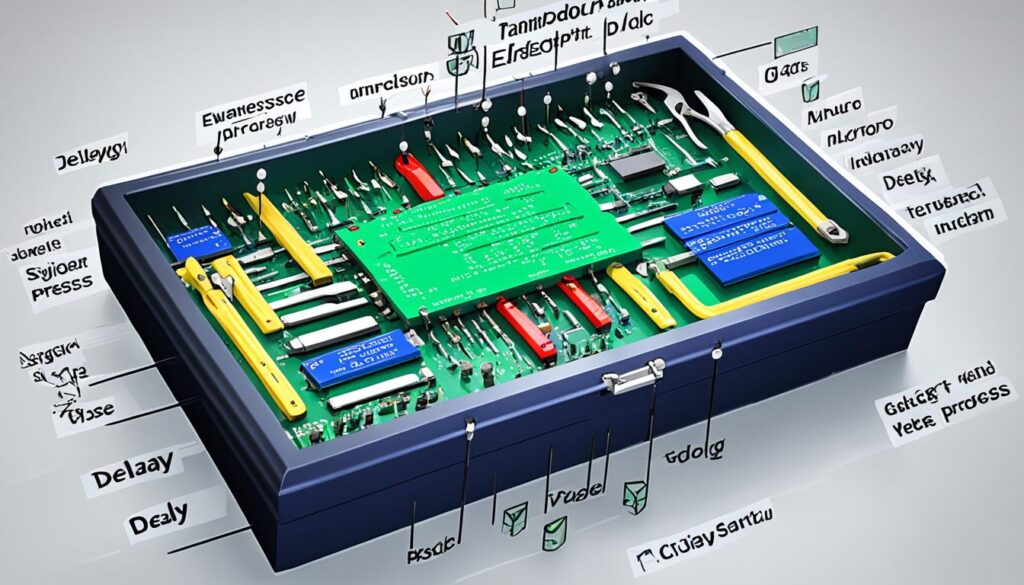Welcome to our article on functions in Verilog, where we explore the significance of these digital code elements in creating efficient designs for hardware. Functions play a crucial role in Hardware Description Language (HDL) by enabling us to write reusable code and streamline complex operations.
In this article, we will provide a comprehensive understanding of functions in Verilog, starting with an introduction to their purpose, syntax, and different types. We will then guide you through the process of creating functions, including defining, declaring, and implementing them in your code. Additionally, we will showcase the benefits of utilizing functions in Verilog, such as improving design efficiency and enhancing code reusability.
Whether you’re a beginner or an experienced designer, mastering functions in Verilog will undoubtedly elevate your skills in digital designs. So, let’s dive into the world of Verilog functions and unlock the potential they hold for creating efficient code elements in HDL.
Table of Contents
Introduction to Functions in Verilog
In this section, we will provide a comprehensive introduction to functions in Verilog, explaining what they are and how they can be utilized in the design process. Verilog functions play a crucial role in creating efficient and reusable code elements for digital designs in Hardware Description Language (HDL).
Understanding Functions in Verilog
Functions in Verilog are blocks of code that perform specific tasks and return a value. They allow us to encapsulate a set of instructions and provide a modular approach to writing code. By breaking down complex operations into smaller functions, we can simplify the overall design process and make our code more readable and efficient.
Verilog functions have a well-defined syntax and can be written in a variety of ways to suit different requirements. They can be used to perform calculations, perform conditional operations, generate values, and more. Functions in Verilog are an integral part of the language and are often used in combination with other elements to create powerful digital designs.
Types of Functions in Verilog
In Verilog, there are two main types of functions: system functions and user-defined functions. System functions are pre-defined functions that are built into the Verilog language and provide basic functionality. They are ready to use and can be called directly in your code without any additional steps.
On the other hand, user-defined functions are functions that we define ourselves to perform specific tasks. These functions are created based on our requirements and can be customized to suit our design needs. User-defined functions give us the flexibility to create highly specialized functions that cater to the unique demands of our digital designs.
An Example of a Verilog Function
Let’s take a look at an example of a Verilog function. Suppose we want to calculate the area of a rectangle based on its width and height. We can create a user-defined function called calculate_area that takes in the width and height as parameters, performs the necessary calculations, and returns the area.
module rectangle;
integer width;
integer height;
function integer calculate_area;
input integer w, h;
begin
return w * h;
end
endfunction
initial begin
width = 5;
height = 10;
$display("The area of the rectangle is %d", calculate_area(width, height));
end
endmodule
In this example, we define the function calculate_area to calculate the area of a rectangle using the provided width and height parameters. We then call this function in the initial block to display the calculated area on the console.
Functions in Verilog offer extensive flexibility and can be used in a wide range of applications to enhance the efficiency and readability of our code. With a solid understanding of functions and their types, we are equipped with powerful tools to create highly optimized and modular designs in Verilog.
Creating Functions in Verilog
In this section, we will guide you through the process of creating functions in Verilog. By understanding how to define, declare, and implement functions in your code, you can enhance the efficiency and reusability of your digital designs in Hardware Description Language (HDL).
Step 1: Function Definition
The first step in creating a function in Verilog is to define its structure. This includes specifying the function’s return type, name, and any input parameters it may require. The function definition serves as a blueprint for its implementation and usage in your code.
Step 2: Function Declaration
Once you have defined your function, you need to declare it before you can use it in your code. The function declaration provides additional information about the function’s name, return type, and input parameters. Declaring a function helps the Verilog compiler understand and validate its usage in your code.
Step 3: Function Implementation
After defining and declaring your function, it’s time to implement its logic. This involves writing the actual code that executes when the function is called. Within the function implementation, you can perform calculations, manipulate data, or execute any other operations necessary to achieve the desired functionality of your function.
Step 4: Parameter Passing and Return Statement
Verilog functions support parameter passing, allowing you to pass values from the calling code to the function. Parameters enable customized and flexible behavior in your functions. Additionally, Verilog functions utilize the return statement to provide an output or result back to the calling code. The return statement allows you to retrieve calculated values or perform specific actions based on the outcome of the function’s execution.
Understanding the process of creating functions in Verilog is crucial for developing efficient and modular code. By utilizing functions, you can simplify complex operations, enhance code reusability, and improve the overall design efficiency of your digital projects.

Benefits of Functions in Verilog
Utilizing functions in Verilog offers numerous advantages that enhance the overall efficiency and effectiveness of your digital designs. In this section, we will explore these benefits in detail and provide practical examples to illustrate their value.
Simplified Code Reusability
Functions in Verilog enable you to encapsulate specific operations or calculations into reusable code segments. By defining functions for commonly-used tasks, you can significantly simplify the design process and reduce the amount of redundant code. This not only streamlines your workflow but also enhances code maintainability and readability.
Improved Design Efficiency
Functions provide a structured and modular approach to designing complex digital systems in Verilog. With functions, you can break down intricate operations into smaller, more manageable tasks. This enables you to focus on individual components, making the design process more efficient and error-free. By promoting code reusability and modularity, functions allow for faster development and easier debugging.
Enhanced Flexibility and Customization
Verilog functions offer a high degree of flexibility and customization, allowing you to tailor your code to specific design requirements. Whether you need to perform arithmetic calculations, create state machines, or implement complex algorithms, functions can be adapted and modified to suit your unique design needs. This versatility empowers you to create optimized and tailored solutions for a wide range of applications.
Promotes Design Scalability
Functions play a vital role in designing scalable digital systems. By encapsulating specific tasks or operations within functions, you can easily expand your design by incorporating or modifying these functions as needed. This promotes design scalability, allowing you to create complex systems without having to rewrite or redesign the entire codebase. Functions enable you to build upon existing functionalities, saving time and effort during the design process.
Code Simplification and Abstraction
By creating functions for complex operations, you can abstract away the implementation details, making the overall code more concise and comprehensible. Functions act as black boxes, emphasizing the functionality rather than the underlying complexities. This simplifies the code structure and improves readability, making it easier to understand, maintain, and debug your Verilog designs.

To summarize, the benefits of utilizing functions in Verilog encompass simplified code reusability, improved design efficiency, enhanced flexibility and customization, design scalability, and code simplification and abstraction. Incorporating functions into your Verilog designs empowers you to create efficient, modular, and scalable digital systems.
| Benefits of Functions in Verilog |
|---|
| Simplified Code Reusability |
| Improved Design Efficiency |
| Enhanced Flexibility and Customization |
| Promotes Design Scalability |
| Code Simplification and Abstraction |
Conclusion
In conclusion, this article has provided a comprehensive understanding of functions in Verilog. Functions play a pivotal role in creating efficient and reusable code elements for digital designs in Hardware Description Language (HDL). By mastering the concept of functions, you can elevate your digital design skills and enhance your productivity in the field of HDL programming.
By incorporating functions in your Verilog designs, you can ensure that your code is modular, organized, and error-free. Functions enable you to break down complex operations into smaller, manageable tasks, making your code more readable and maintainable. Additionally, functions promote code reusability, allowing you to save time and effort by utilizing existing code elements in different parts of your design.
Whether you are a beginner or an experienced professional, understanding how to create and use functions in Verilog is essential for optimizing your digital designs. With the knowledge gained from this article, you are equipped to create efficient, reusable, and error-free code elements in HDL. Embrace the power of functions in Verilog and unlock new possibilities in your digital design journey!

